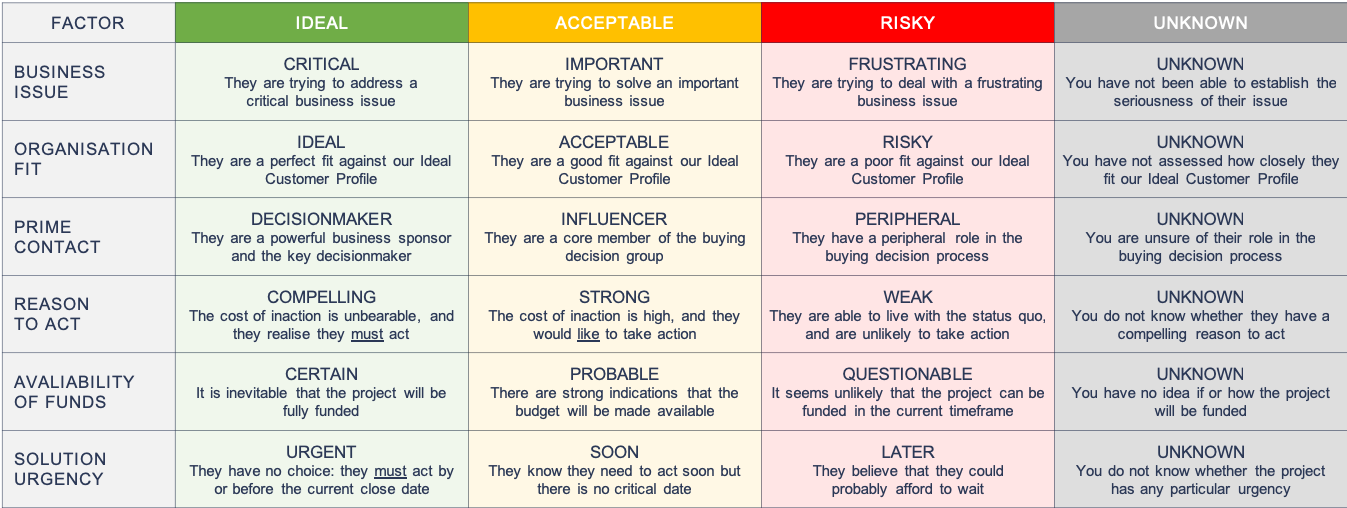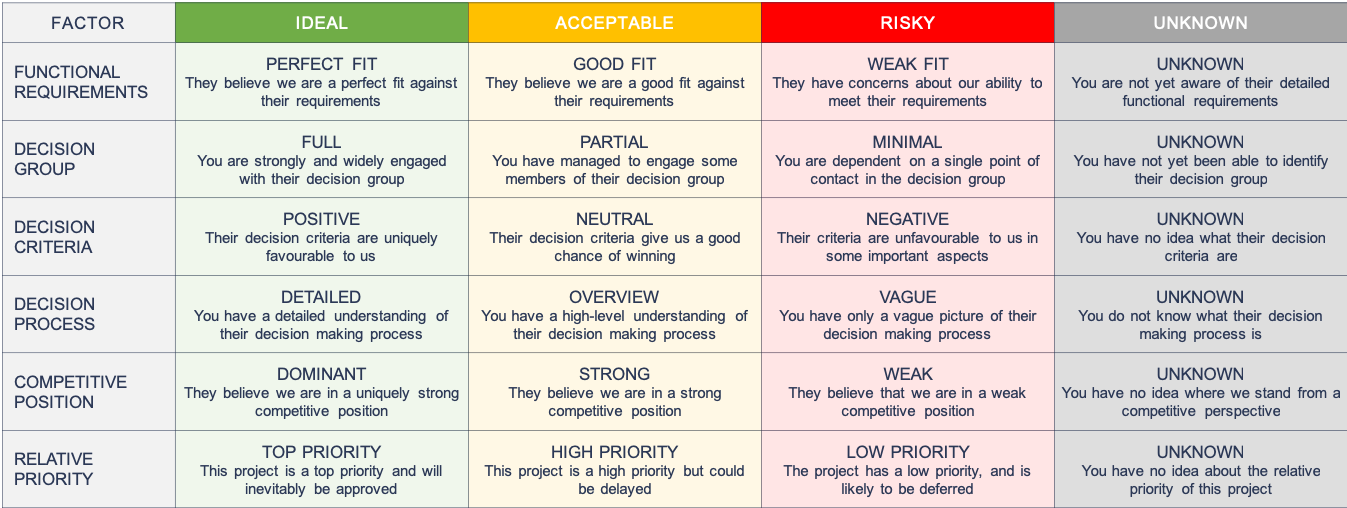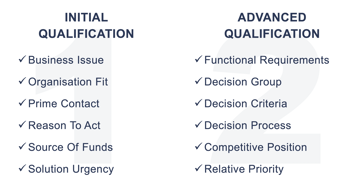- AMBER = an acceptable fit against our qualification criteria
- RED = a risk factor or a negative fit against our qualification criteria
- GREY = unknown – we are currently unable to assess this factor
For each of the 12 factors, you need to establish a simple and consistent definition of what each of these levels of qualification means in practice in your environment. And I strongly recommend that when your sales people capture their current assessments in CRM that you require them to include a brief one-line commentary about how they arrived at their conclusion for each factor.
You also need to establish an atmosphere where it’s OK to admit – rather than guessing – that your sales people don’t have sufficient evidence to rate a factor as anything other than unknown (as long as the sales person them redoubles their efforts to get to the truth), and where it’s OK – and in fact highly desirable – to proactively qualify out a bad opportunity as early as possible in the cycle.
Let’s start with the initial qualification factors:
INITIAL QUALIFICATION FACTORS

Business Issue
Has your customer acknowledged a clearly defined business issue that your organisation is really good at solving?
Organisation Fit
How closely is your prospective customer organisation aligned with your Ideal Customer Profile? If you haven’t established an Ideal Customer Profile, you need to!
Prime Contact
Is your prime contact the ultimate decision-maker, a powerful influencer or peripheral to the final decision? This is a critical consideration.
Reason to Act
Does your customer have a clear and compelling business justification to take action? This is typically far more important than having a vaguely defined “need”.
Availability of Funds
Is the customer ready, willing and able to fully fund the project? Note that the presence of a powerful budget shaper may be far more significant than the existence of a formally established budget
Solution Urgency
Is there a compelling reason why this project needs to happen now, rather than later (or at all)? Without urgency, even if they want you, they can probably wait.
The first three factors can often be established before a marketing-generated opportunity can be regarded as “sales ready”. All six factors should be established before you allocate significant resources to pursuing the opportunity.
Now let’s turn to the remaining six advanced qualification factors:
ADVANCED QUALIFICATION FACTORS

The remaining factors typically require a significant level of involvement with the prospective customer before they can be accurately established.
Functional Requirements
What are the customer’s functional requirements, and are they a good fit against our key capabilities? Hopefully you will have influenced them.
Decision Group
Have you identified and engaged all their key stakeholders, and what is your relationship with them? The decision group is usually larger than you might think!
Decision Criteria
What are their decision criteria, to what extent have you influenced them, and are they favourable to us?
Decision Process
Are you sure you have fully understood all the key steps in their decision process and timeframe?
Competitive Position
Are you sure you have identified all their other solution options, and do you know where you stand against them?
Relative Priority
How does this project rank against all the other projects competing for their attention/funding? This is frequently ignored but always important.
These remaining six advanced qualification criteria need to be assessed before any attempt is made to forecast the opportunity. And given the complexities of a typical lengthy B2B buying journey, and the fact that changes are nigh-on-inevitable, all twelve criteria need to be reassessed before an opportunity is promoted to the next stage of the pipeline or whenever the customer’s circumstances change.
BETTER THAN BANT
These 12 criteria, I hope you will agree, offer a far more complete and realistic assessment than BANT. And to anyone who think that 12 criteria are too many, I would simply ask you to consider whether any factor is unlikely to affect the outcome of an opportunity.
If it is genuinely irrelevant to your chances of winning the deal, you can safely leave it out of your qualification regime. But I’d encourage you think carefully before you hit the “delete” button. And, of course, there may be factors that are very specific to your typical sales situation that you will want to add.
CONSISTENT APPLICATION
Of course, what really matters is that your entire sales team consistently applies whatever qualification criteria you define, and that your sales managers are expected to evaluate the rigour with which their sales people are qualifying their opportunities.
If inconsistencies are common, you may need to refine exactly what you mean for each of the GREEN–AMBER–RED levels of each factor. And you may need to reaffirm that the purpose of qualification is not to make your sales people’s pipelines look good (for the moment, at least), but to help to ensure that they invest their precious selling time on opportunities that they have a realistic chance of winning.
And please don’t set arbitrary pipeline coverage targets that encourage sales people to cling on to opportunities that they should in all honesty have abandoned long ago.
A PROGRESSIVE APPROACH
So there you have it – my provably effective alternative to BANT. If you’re unconvinced, I suggest you try it. And don’t be surprised if your forecasts become a lot more accurate as a result. Drop me a line if you’d like to discuss how this methodology could be implemented in your organisation.

 Like a growing number of other commentators, I have come to believe that the traditional BANT (Budget, Authority, Need and Timeframe) approach to sales opportunity qualification is fundamentally flawed and not fit for purpose when it comes to complex B2B sales.
Like a growing number of other commentators, I have come to believe that the traditional BANT (Budget, Authority, Need and Timeframe) approach to sales opportunity qualification is fundamentally flawed and not fit for purpose when it comes to complex B2B sales.

